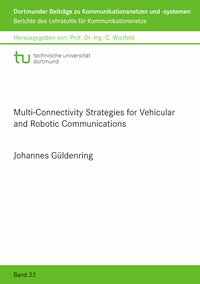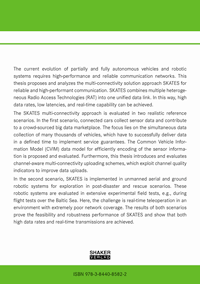
Shop : Details
Shop
Details
48,80 €ISBN 978-3-8440-8582-2Softcover190 pages68 figures281 g21 x 14,8 cmEnglishThesis
May 2022
Johannes Güldenring
Multi-Connectivity Strategies for Vehicular and Robotic Communications
The current evolution of partially and fully autonomous vehicles and robotic systems requires high-performance and reliable communication networks. This thesis proposes and analyzes the multi-connectivity solution approach SKATES for reliable and high-performant communication. SKATES combines multiple heterogeneous Radio Access Technologies (RAT) into one unified data link. In this way, high data rates, low latencies, and real-time capability can be achieved.
The SKATES multi-connectivity approach is evaluated in two realistic reference scenarios. In the first scenario, connected cars collect sensor data and contribute to a crowd-sourced big data marketplace. The focus lies on the simultaneous data collection of many thousands of vehicles, which have to successfully deliver data in a defined time to implement service guarantees. The Common Vehicle Information Model (CVIM) data model for efficiently encoding of the sensor information is proposed and evaluated. Furthermore, this thesis introduces and evaluates channel-aware multi-connectivity uploading schemes, which exploit channel quality indicators to improve data uploads.
In the second scenario, SKATES is implemented in unmanned aerial and ground robotic systems for exploration in post-disaster and rescue scenarios. These robotic systems are evaluated in extensive experimental field tests, e.g., during flight tests over the Baltic Sea. Here, the challenge is real-time teleoperation in an environment with extremely poor network coverage. The results of both scenarios prove the feasibility and robustness performance of SKATES and show that both high data rates and real-time transmissions are achieved.
The SKATES multi-connectivity approach is evaluated in two realistic reference scenarios. In the first scenario, connected cars collect sensor data and contribute to a crowd-sourced big data marketplace. The focus lies on the simultaneous data collection of many thousands of vehicles, which have to successfully deliver data in a defined time to implement service guarantees. The Common Vehicle Information Model (CVIM) data model for efficiently encoding of the sensor information is proposed and evaluated. Furthermore, this thesis introduces and evaluates channel-aware multi-connectivity uploading schemes, which exploit channel quality indicators to improve data uploads.
In the second scenario, SKATES is implemented in unmanned aerial and ground robotic systems for exploration in post-disaster and rescue scenarios. These robotic systems are evaluated in extensive experimental field tests, e.g., during flight tests over the Baltic Sea. Here, the challenge is real-time teleoperation in an environment with extremely poor network coverage. The results of both scenarios prove the feasibility and robustness performance of SKATES and show that both high data rates and real-time transmissions are achieved.
Keywords: Multi-Connectivity; Multi-RAT; Multi-Link; SKATES; CVIM; Vehicle Big Data; Rescue Robotics; Communication
Dortmunder Beiträge zu Kommunikationsnetzen und -systemen
Edited by Prof. Dr.-Ing. C. Wietfeld, Dortmund
Volume 22
Export of bibliographic data
Shaker Verlag GmbH
Am Langen Graben 15a
52353 Düren
Germany
Am Langen Graben 15a
52353 Düren
Germany
Mon. - Thurs. 8:00 a.m. to 4:00 p.m.
Fri. 8:00 a.m. to 3:00 p.m.
Fri. 8:00 a.m. to 3:00 p.m.
Contact us. We will be happy to help you.



